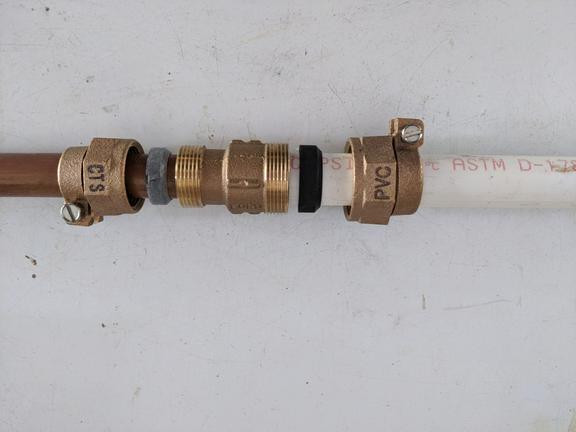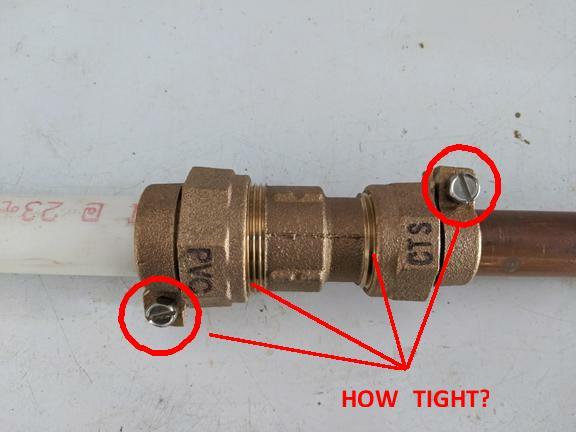 
Over 698,000 strictly plumbing related posts
Plumbing education, information, advice, help and suggestions are provided by some of the most experienced plumbers who wish to "give back" to society. Since 1996 we have been the best online (strictly) PLUMBING advice site. If you have questions about plumbing, toilets, sinks, faucets, drains, sewers, water filters, venting, water heating, showers, pumps, and other strictly PLUMBING related issues then you've come to the right place. Please refrain from asking or discussing legal questions, or pricing, or where to purchase products, or any business issues, or for contractor referrals, or any other questions or issues not specifically related to plumbing. Keep all posts positive and absolutely no advertising. Our site is completely free, without ads or pop-ups and we don't tract you. We absolutely do not sell your personal information. We are made possible by: 
|
|
Author:
sum (FL)
I have a water supply line from the meter that is 3/4" PVC. This line is 16" or so below grade, and about 5" from the house exterior wall. I will be transitioning this PVC to 3/4" copper then run vertically up along the wall before entering the building.
To facilitate the transition I have purchased a FORD 3/4" IPS to 3/4" CTS coupling. This is the first time I am using this coupling so I would appreciate some pro advice here.
I took a short piece of 3/4" PVC and 3/4" type L copper and did a quick test fit.

QUESTION #1: Should this fitting be best used horizontally or vertically? In other words, should I connect this coupling to the horizontal PVC pipe, then a short piece of copper, then a copper 90 to go vertical followed by the ball valve? Or should I connect the PVC with a 90 elbow, go up a bit with the PVC, then use this coupling in the vertical position? Or does it not matter?
QUESTION #2: The existing PVC pipe is 5" off the wall. I would like the vertical copper pipe to be close to the wall, so I need to offset the pipe somewhere. Again I am debating if I should use more PVC pipes and fittings to offset it first, or to transition it to copper first then use copper for the offset? I think I can do it either way but may be it is harder to solder in a trench unless I preassemble the copper piece.
Finally, I see two "collars" on each side of this coupling, these collars have hex shaped nuts to tighten. What is the purpose of these two collars? I think the compression sealing is done by the big compression nuts not the collars.

QUESTION #3: The compression nuts I assume I need to tighten them quite a bit, with two big wrenches. Is there some kind of visual cue to tell me it's tight enough? In the picture above, should I tighten them until I see a certain number of threads remaining? or should I hand tight them then do another 360 turn with a wrench? Or should I tighten them with two big wrenches until my nose starts to bleed?
QUESTION #4: The nut on the collars, how tight should I tighten those? Would overtightening collapse the PVC pipe? I assume they should be tightened AFTER the big compression nuts are tightened?
Edited 5 times.
|
|
Post Reply
|
|
|
Author:
srloren (CA)
Your assumptions are right but be sure to hold a backup wrench on the brass space between the threaded sections of the pipe. Tighten until hand tight then another 3/4 turn and test it if it still leaks tighten a little more and so on. Just remember to tighten the bolts last.
srloren
Edited 1 times.
|
|
Post Reply
|
|
|
Author:
packy (MA)
sum, use those any way and any direction you want.
i use a dab of grease when tightening them
the hex bolts are meant to grab onto the pipe to keep it from pulling out. the compression sleeve will not do that.
i would tighten things very well.
the bolts i tighten with a nut driver as tight as my hands will make it.
|
|
Post Reply
|
|
|
Author:
hj (AZ)
If it is NOT tight enough when you pressurize it, it will probably blow apart. Tighten it until you cannot tighten it any more.
|
|
Post Reply
|
|
|
Author:
bernabeu (SC)
sum,
as per Ford's directions: tighten 1-1/2 turns beyond the start of compression
tighten one side at a time while 'holding back' the middle - NO LUBRICANT NECESSARY OR RECOMMENDED
the outer nuts function as clamps to prevent the coupling from 'blowing apart' - they get tightened 'all the way'
the compression/seal gaskets do NOT get tightened 'all the way'
THE SEAL/GASKET YOU SHOW ON THE PVC IS REVERSED - THE BEVEL GOES INTO THE BODY OF THE FITTING (just like a tubular slip joint washer)
==============================================
"Measure Twice & Cut Once" - Retired U.A. Local 1 & 638
Edited 1 times.
|
|
Post Reply
|
|
|
Author:
sum (FL)
"as per Ford's directions: tighten 1-1/2 turns beyond the start of compression
tighten one side at a time while 'holding back' the middle - NO LUBRICANT NECESSARY OR RECOMMENDED
the outer nuts function as clamps to prevent the coupling from 'blowing apart' - they get tightened 'all the way'
the compression/seal gaskets do NOT get tightened 'all the way'"
I was wondering if I should be holding the middle portion, however, the middle portion has no "flats". Has a few small ridges. I hope my plier can hold it steady.
Since this is happening in a trench, against the wall, and obviously the small hex screws are to be tightened last once the big compression nuts are done. So there is a chance once I get it tightened...what if the hex screws end up facing the wall or facing down? There is no way I can tighten them then. So does that mean I will go another 1/2 turn beyond "tight enough" to get the hex screws to face up?
or should I take a different approach, connect a short piece of PVC and a short piece of copper, tighten them in the shop with the coupling clamped with a vise, once that joint is made with the hex screws both facing the same direction, I connect it to the existing PVC with a PVC coupling, and rotate the assembly to face up?
|
|
Post Reply
|
|
|
Author:
sum (FL)
I hope it will not blow apart, I am going to tighten it as much as I can but it's hard to get a feel the first time.
How is this different from a compression angle valve under the sink? It is under the same pressure right? But a compression angle valve is held together by the compression nut pressing against a brass ferrule, no collar like this one. I am a bit surprise the guts inside this fitting are rubber/plastic rings and not brass.
Edited 1 times.
|
|
Post Reply
|
|
|
Author:
packy (MA)
the reason for rubber sleeve and not metal is because the fitting is commonly used on soft copper tubing which is not perfectly round.
i still use silicone grease to help make things slipperier. especially on the stainless screw/bolt.
if you have enough room to get the jaws of a pipe wrench to grab the brass nut then there is enough room to get a small open end wrench onto the stainless bolt.
|
|
Post Reply
|
Please note:
- Inappropriate messages or blatant advertising will be deleted. We cannot be held responsible for bad or inadequate advice.
- Plbg.com has no control over external content that may be linked to from messages posted here. Please follow external links with caution.
- Plbg.com is strictly for the exchange of plumbing related advice and NOT to ask about pricing/costs, nor where to find a product (try Google), nor how to operate or promote a business, nor for ethics (law) and the like questions.
- Plbg.com is also not a place to ask radiant heating (try HeatingHelp.com), electrical or even general construction type questions. We are exclusively for plumbing questions.
Search for plumbing parts on our sponsor's site:
Special thanks to our sponsor:

|





